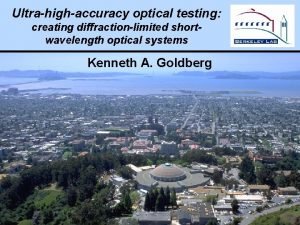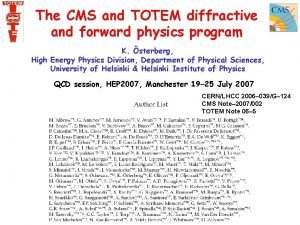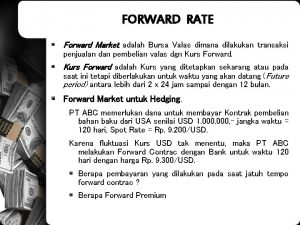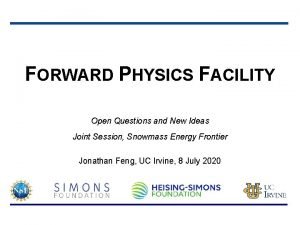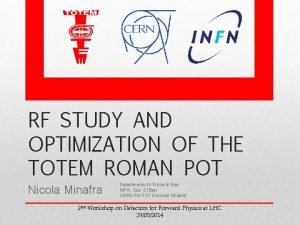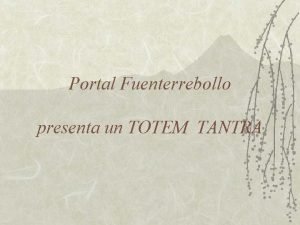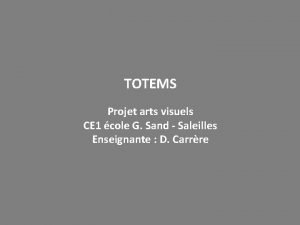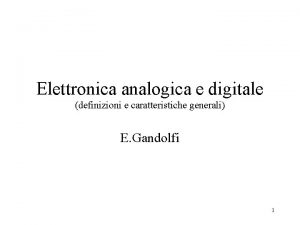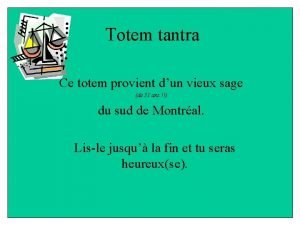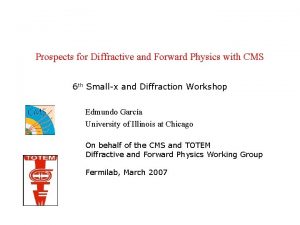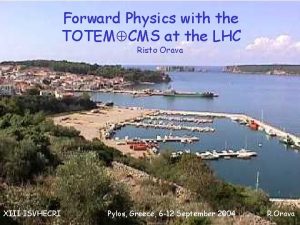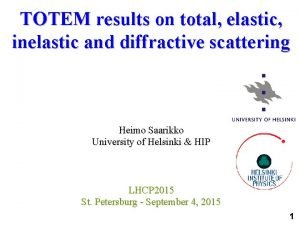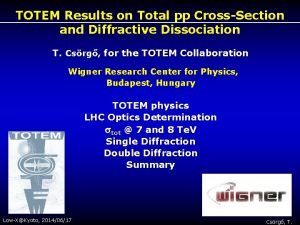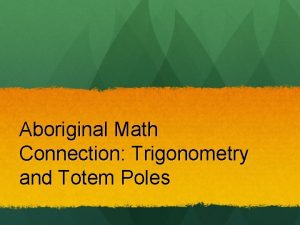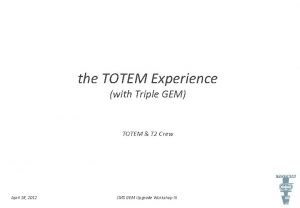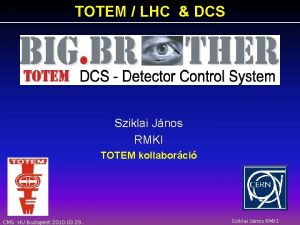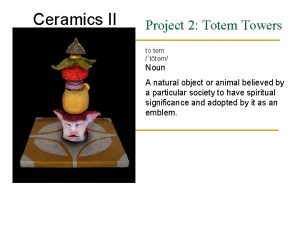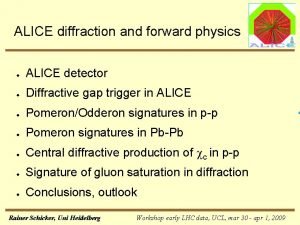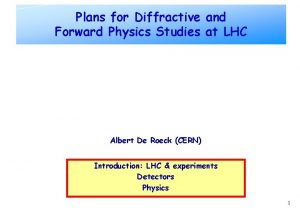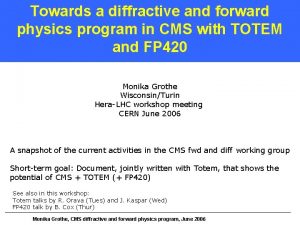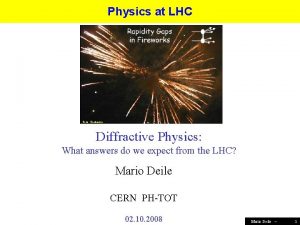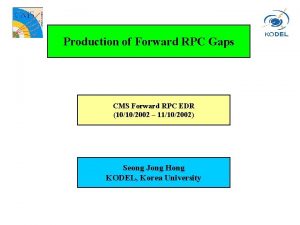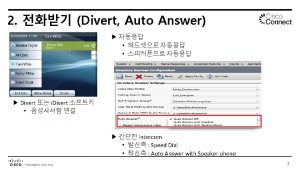The CMS and TOTEM diffractive and forward physics







![Triggering on soft & semi-hard diffraction Estimated Rates (Hz) [acceptance corrected] L =1030 cm Triggering on soft & semi-hard diffraction Estimated Rates (Hz) [acceptance corrected] L =1030 cm](https://slidetodoc.com/presentation_image/35f3f77f81d198d7cd70607565a969f1/image-8.jpg)


















- Slides: 26

The CMS and TOTEM diffractive and forward physics program K. Österberg, High Energy Physics Division, Department of Physical Sciences, University of Helsinki & Helsinki Institute of Physics QCD session, HEP 2007, Manchester 19 25 July 2007 CERN/LHCC 2006 039/G 124 CMS Note 2007/002 TOTEM Note 06 5

Diffraction: a window to QCD and proton structure Double Pomeron Exchange or Central Diffraction: Single Diffraction: X Central & forward det. Proton det. Gap pp p. X X Proton det. Gap pp p. Xp Central & forward det. Proton det. characterized by 2 gluon exchange with vacuum quantum numbers (“Pomeron”) X = anything : dominated by soft physics Measurement of inclusive cross sections + their t & MX dependence fundamental measurements of non perturbative QCD at LHC! X = jets, W, Z, Higgs: hard processes calculable in perturbative QCD Proton structure (d. PDFs & GPDs), high parton density QCD, rapidity gap survival probability, new physics searches in exclusive central diffraction

Experimental apparatus at IP 5@LHC T 1: 3. 1 < < 4. 7 Tracking Calorimetry T 2: 5. 3 < < 6. 5 (same as Castor) 10. 5 m IP 5 HF CASTOR 14 m FP 420 ZDC IP 5 147 m 220 m Roman Pots

CMS/TOTEM combined acceptance TOTEM CMS Log( ), = p/p Charged particle flow Energy flow Charged particle Unique coverage makes a wide range of physics studies possible from diffraction & proton low-x dynamics to production of SM/MSSM Higgs TOTEM > 10 % acceptance for RP 220 m low * 420 m proton detectors @ low * * = 1540 * = 90 Log( t [Ge. V 2]) Wide coverage in pseudorapidity & proton detection At high L proton detectors @420 m enlarge acceptance to ~ 2 10 3 For details see A. De Roeck’s talk on FP 420 in combined EWK/QCD session

Running scenario pp->p. Xp soft diffraction pp->pjj. Xp (semi)-hard diffraction pp->pjj (bosons, heavy pp->pjjp quarks, Higgs. . . ) hard diffraction cross section * (m) luminosity mb b 1540 90 2 0. 5 1030 1032 1034 L (cm 2 s 1) 1028 TOTEM runs nb Standard runs Accessible physics depends on: luminosity * (i. e. proton acceptance)

Low x physics high s @ LHC allows access to quark & gluon densities for small Bjorken x values: fwd Drell-Yan (jets) sensitive to quarks (gluons) > 5 & M < 10 Ge. V x ~ 10 6 10 7 T 2 + CASTOR !! M 2 of Drell Yan pairs in CASTOR x of Drell Yan pairs in CASTOR

Forward physics Forward particle & energy flow: validation of hadronic air shower models, possible new phenomena… Study of underlying event & p mediated processes: e. g. exclusive dilepton production ( ) (true) known rms ~ 10 -4 Calibration process for luminosity and energy scale of proton taggers Allows reconstruction of proton value with a 10 4 resolution < beam energy spread Striking signature: acoplanarity angle between leptons
![Triggering on soft semihard diffraction Estimated Rates Hz acceptance corrected L 1030 cm Triggering on soft & semi-hard diffraction Estimated Rates (Hz) [acceptance corrected] L =1030 cm](https://slidetodoc.com/presentation_image/35f3f77f81d198d7cd70607565a969f1/image-8.jpg)
Triggering on soft & semi-hard diffraction Estimated Rates (Hz) [acceptance corrected] L =1030 cm 2 s 1 L =1032 cm 2 s 1 * = 90 m * = 2 m --------------------------------- 1 p 14 mb T 1/T 2 6000 1. 4 105 2 p T 1/T 2 200 3. 5 103 1 mb 1 b 1 p (p jet>20 Ge. V) 0. 2 T T 1/T 2 30 nb jet(s) (p jet>50 Ge. V) 0. 01 T 0. 5 60 nb 2 p jet 3 (p >20 Ge. V) 7 10 T T 1/T 2 1. 5 nb jet(s) (p. Tjet>50 Ge. V) 0. 03 Usable for extracting diffractive PDFs & rapidity gap survival probability

Diffraction at low luminosity: soft central diffraction MX = 1 2 s Study of mass distribution via the 2 protons trigger: 2 p + T 1/T 2, rate: ~ 200 Hz @ = 90 m, L = 1030 cm 2 s 1 Acceptance 1/N d. N/d. MX [1/10 Ge. V] measured directly ( ( ) ~ 1. 6 10 3 @ = 90 m) or ( )/ ~ 80 % with rapidity gap = ln with calorimeters i ETi e i / s ( )/ ~ 100 % Differential mass distribution, acceptance corrected Mass resolution, = 90 m, RP@220 m asymmetric events low MX [Ge. V] Best resolution for symmetric events

Diffraction at high luminosity: central exclusive production New physics searches e. g. (pp p H(120 Ge. V)[ bb] p) ~ 3 fb (KMR) JPC selection (0++. . . ) qq background heavily suppressed Selection: 2 protons + 2 b-jets with consistent mass values Experimental issues: trigger efficiency & pileup background (MX)/MX Acceptance in some MSSM scenarios much larger, H WW if H heavier @ s r o ct m 0 2 4 ete d n ! NB roto p es m ssu A MX [Ge. V]

Diffraction at high luminosity: triggering on diffraction dedicated diffractive trigger stream foreseen at L 1 & HLT (1 k. Hz & 1 Hz) standard trigger thresholds too high for diffraction at nominal optics use information from fwd detectors to lower particular trigger thresholds L 1: 33 cm 2 s 1) ● jet E > 40 Ge. V ( standard 2 jet threshold: ~100 Ge. V @ L = 2 10 T ● 1 (or 2) arm RP@220 m ● diffractive topology (fwd rap gaps, HLT (more process dependent): ● e. g. 420 m proton detectors, mass constraint, b-tagging. . Efficiency jet proton hemisphere correlation …) bench mark process: central exclusive H(120 Ge. V) bb L 1: ~ 12 % HLT: ~ 7 % additional ~ 10 % efficiency @ L 1 with a 1 jet + 1 (40 Ge. V, 3 Ge. V) trigger 420 m 220 m 420+420 m 420+220 m L 1 trigger threshold [Ge. V]

Diffraction at high luminosity: reducing pileup background At high luminosity, non-diffractive events overlaid by soft diffractive events mimic hard diffractive events (“pileup background”) correlation btwn & mass measured with central detector and proton detectors ● fast timing detectors to distinguish proton origin & hard scattering vertex from each other (R&D project) central exclusive H bb (jets) Pileup background reduction: (jets) Pileup event probability with single proton in RP@220 m (420 m) ~ 6 % (2 %) probability for fake central diffractive signal caused by pileup protons QCD 2 -jets + pileup p’s ● (RP@220 m) depends on LHC diffractive proton spectrum rapidity gap survival probability

CMS 2008 diffractive & forward program First analysis in 2008 most likely based on large rapidity gap selection Even if RP@220 m available need time to understand the data … Concentrate first analysis on data samples where pileup negligible Developing rapidity gap trigger with forward calorimeters (HF, CASTOR…) Program: “Rediscover” hard diffraction a la Tevatron, for example: ● measure fraction of W, Z, dijet and heavy flavour production with large rapidity gap ● observe jet-gap-jet and multi-gap topologies Forward physics with CASTOR ● measure forward energy flow, multiplicity, jets & Drell-Yan electrons & p interactions, for example ● observe exclusive di-lepton production For TOTEM program see my ”TOTEM: total cross section measurement” talk

Summary CMS and TOTEM diffractive and forward physics program CMS+TOTEM provides unique pseudo-rapidity coverage Integral part of normal data taking both at nominal & special optics Low Luminosity (< 1032 cm-2 s-1): nominal & special optics Single & central diffractive cross sections (inclusive & with jets, rapidity gap studies) Low x physics Forward Drell-Yan & forward inclusive jets Validation of Hadronic Air Shower Models Running with TOTEM optics: large proton acceptance Increasing Luminosity (> 1032 cm-2 s-1): nominal optics Single & central diffraction with hard scale (dijets, W, Z, heavy quarks) d. PDF’s, GPD’s, rapidity gap survival probability & p physics Pileup not negligible: important background source No pileup High Luminosity (> 1033 cm-2 s-1) : nominal optics Need additional Characterise Higgs or new physics in central diffraction? proton detectors


Content of common physics document Includes important experimental issues in measuring forward and diffractive physics but not an exhaustive physics study Detailed studies of acceptance & resolution of forward proton detectors Trigger Background Reconstruction of kinematical variables Several processes studied in detail Ch 1: Ch 2: Ch 3: Ch 4: Ch 5: Ch 6: Introduction Experimental Set-up Measurement of Forward Protons Machine induced background Diffraction at low and medium luminosity Triggering on Diffractive Processes at High Luminosity Ch 7: Hard diffraction at High Luminosity Ch 8: Photon-photon and photon-proton physics Ch 9: Low-x QCD physics Ch 10: Validation of Hadronic Shower Models used in cosmic ray physics An important milestone for collaboration between the two experiments

Forward proton measurement: principle y(mm) Diffractive protons : hit distribution @ RP 220 low * (0. 5 - 2 m) high * (90 m) y ~ yscatt ~ | ty | x~ 10 p/p x(mm) 10 x(mm) Detect the proton via: its momentum loss (low *) its transverse momentum (high *)

Running scenarios Physics: low |t| elastic, large |t| elastic Soft diffraction tot , Soft & semi-hard diffraction min bias *[m] 1540 (90) 18, 2, 0. 5 1540 90 N of bunches 43 2808 156 N of part. per bunch 0. 3 1. 15 (0. 6 - 1. 15) 1. 15 0 160 0 0 Transv. norm. emitt. [ m rad] 1 (3. 75) 3. 75 1 - 3. 75 RMS beam size at IP [ m] 454 (200) 95 454 - 880 200 RMS beam diverg. 0. 29 (2. 3) 5. 28 0. 29 - 0. 57 2. 3 1. 6 (7. 3) x 1028 3. 6 x 1032 2. 4 x 1029 2 x 1030 (x 1011) Half crossing angle [ rad] Peak luminosity [cm-2 s-1]

Diffraction at low luminosity: rapidity gaps Measure via rapidity gap: = ln diffractive system X p 2 Achieved resolution: ( )/ 80 % Gap vs ln ( ) T 1+T 2+Calorimeters p 1 min max * = 90 * = 2 same acceptance / limit ln = 2 10 3 2 10 2 Gap measurement limit due to acceptance of T 2

assumed cross sections d /dp. T ( b) Diffraction at medium luminosity: semi-hard diffraction Measure cross sections & their t, MX, p. Tjet dependence SD: pp->pjj. X access to d. PDF’s and rapidity gap survival probability N event collected [acceptance included] CD: pp->pjj. Xp p. Tjet(Ge. V) In case of jet activity can also be determined from calorimeter info: i ETi e i / s ( )/ 40 % Event topology: exclusive vs inclusive jet production * = 90 m ∫L dt = 0. 3 pb 1 SD: p. T>20 Ge. V 6 x 104 CD: “ 2000 * = 2 m ∫L dt = 100 pb 1 SD: p. T>50 Ge. V 5 x 105 CD: “ 3 x 10 4

Log( ), = p/p Forward proton measurement: acceptance (@220 m & 420 m) RP 220 m *= 0. 5 2 m * = 2/0. 5 FP 420 * = 1540 420 m 220 m * = 90 Log( t) Proton detectors at 420 m would enlarge acceptance range down to = 0. 002 at high luminosity (= low *).

Forward proton measurement: momentum resolution ( * = 90 m) ( ) Individual contribution to the resolution: total 220 m Transverse vertex resolution (30 m) Beam position resolution (50 m) Detector resolution (10 m) Final state dependent; 30 m for light quark & gluon jets p/p

Forward proton measurement: momentum resolution ( * = 2/0. 5 m) Detector resolution (10 m) ( )/ Individual contribution to the resolution: total Beam position resolution (50 m) Transverse vertex resolution (10 m) Relative beam energy spread (1. 1 10 4) Very little final state dependence since transverse IP size is small. * = 90 m vs. * = 2/0. 5 m p/p Better ( )/ for * = 2/0. 5 m & larger luminosity but limited acceptance ( > 0. 02)

Cosmic ray connection Interpreting cosmic ray data depends on cosmic shower simulation programs Forward hadronic scattering poorly known/constrained Models differ up to a factor 2 or more Need forward particle/energy measurements at high center-of-mass energy (LHC Elab=1017 e. V) Achievable at low luminosity using T 1/T 2/HF/Castor

Low-x physics: forward jets Inclusive forward “low-ET” jet (ET ~20 -100 Ge. V) production: p + p → jet 1 + jet 2 + X 1 pb-1 Sensitive to gluons with: x 2 ~ 10 -4, x 1 ~ 10 -1 PYTHIA ~ NLO Large expected yields (~107 at ~20 Ge. V) !

Diffractive PDF’s and GPD’s hard scattering • Diffractive PDFs: probability to find a parton of given x under condition that proton stays intact – sensitive to low-x partons in proton, complementary to standard PDFs jet IP d. PDF GPD jet GPD • Generalised Parton Distributions (GPD) quantify correlations between parton momenta in the proton t-dependence sensitive to parton distribution in transverse plane When x’=x, GPDs are proportional to the square of the usual PDFs
 Diffractive null test
Diffractive null test Totem cms
Totem cms Currency forward market
Currency forward market Forward rate dan forward market
Forward rate dan forward market Forward physics facility
Forward physics facility What is cole's idea to cure peter's depression
What is cole's idea to cure peter's depression Bumblebee totem pole
Bumblebee totem pole Totem by thomas king
Totem by thomas king Tlingit totem pole meanings
Tlingit totem pole meanings Rf totems
Rf totems Totem tantra
Totem tantra Win win win lose lose lose
Win win win lose lose lose Tlingit totem pole meanings
Tlingit totem pole meanings Arts visuels totem cycle 2
Arts visuels totem cycle 2 Totem tantra
Totem tantra Patrol totem
Patrol totem Totem pole badger
Totem pole badger Totem poles pictures
Totem poles pictures Totem pole elettronica
Totem pole elettronica Totem mentor
Totem mentor Spell totem pole
Spell totem pole Totem tantra
Totem tantra Totem ocean trailer express
Totem ocean trailer express Tantra totem
Tantra totem Tantra totem
Tantra totem Totem conlog
Totem conlog Why does it happen
Why does it happen
